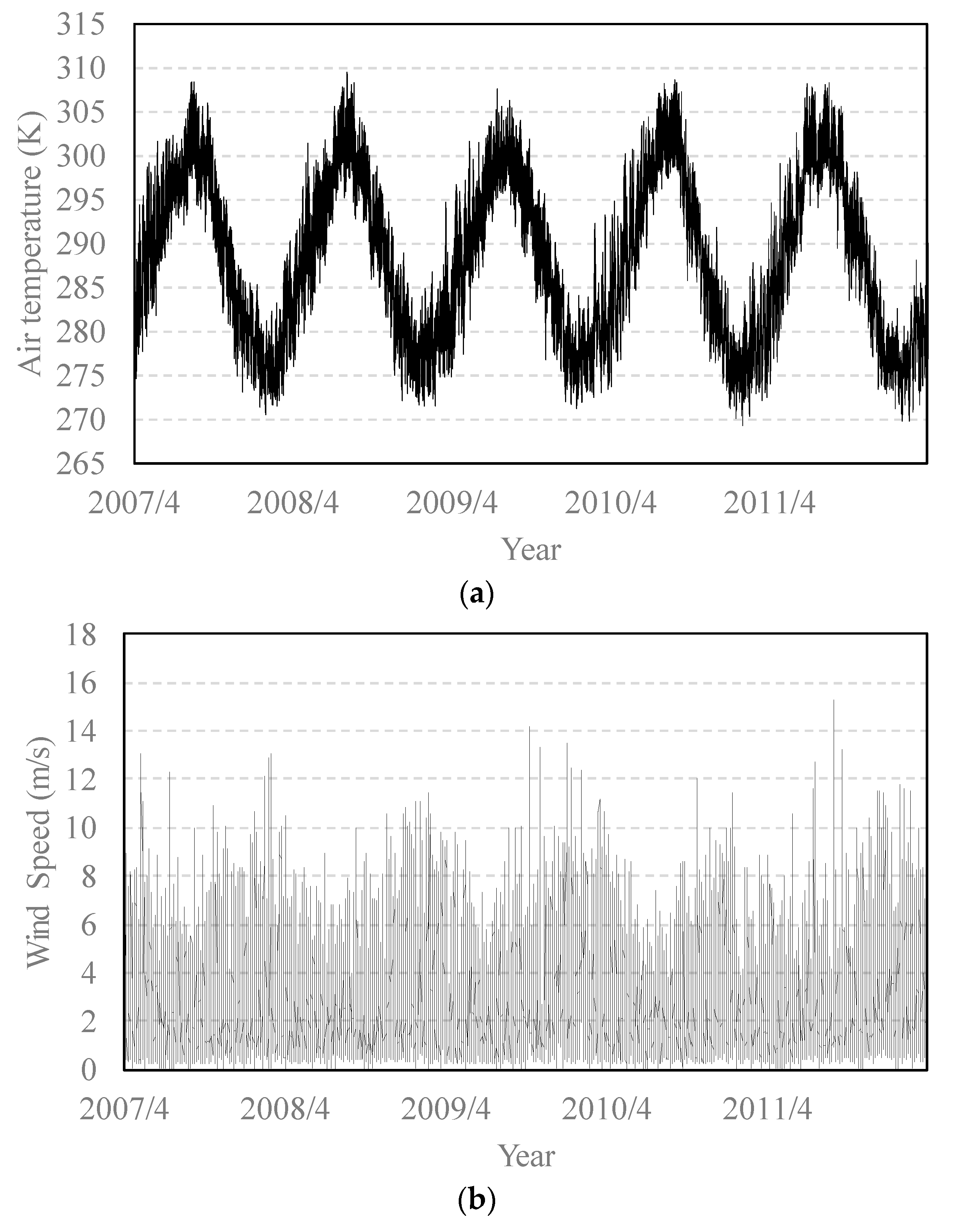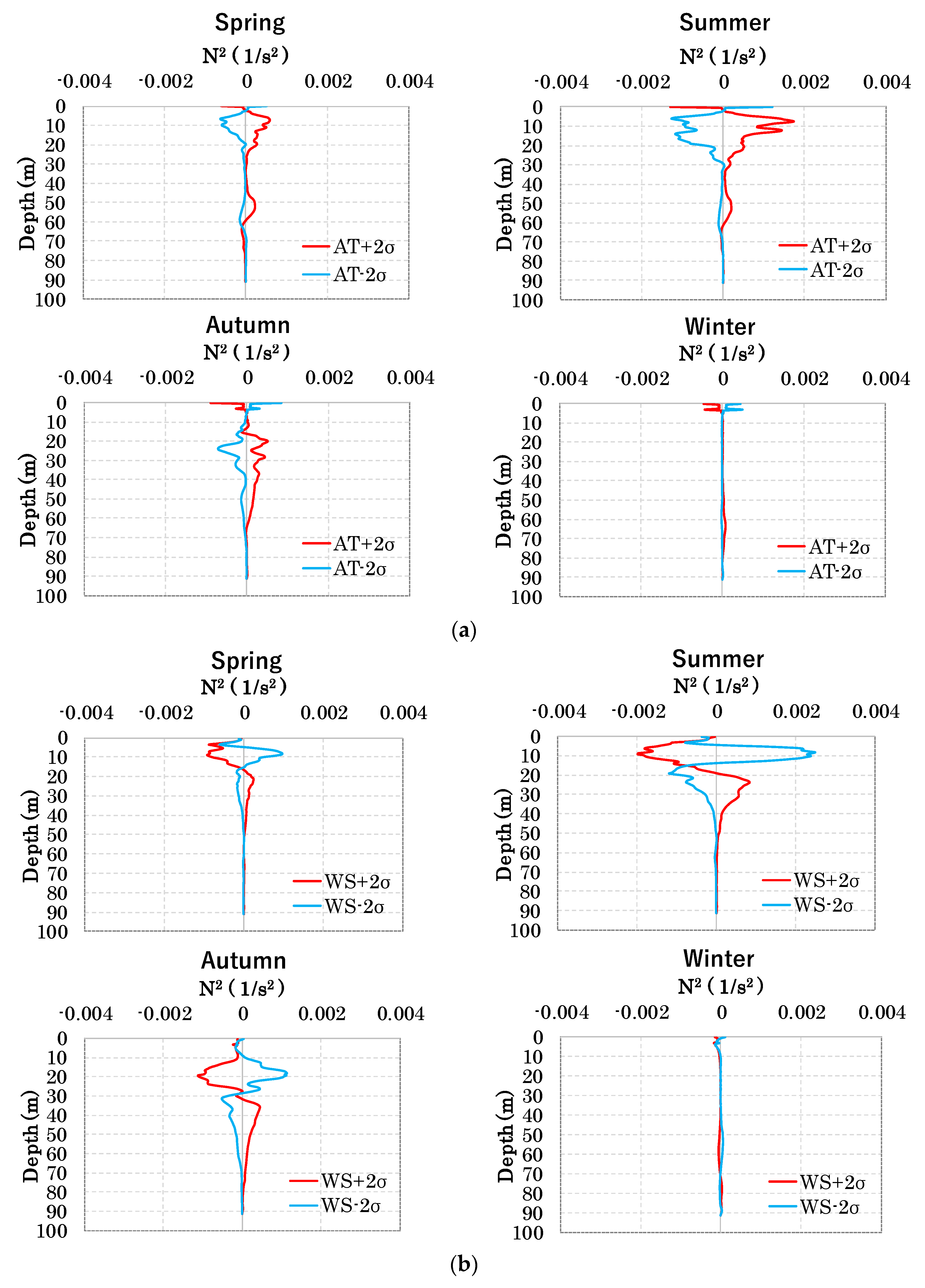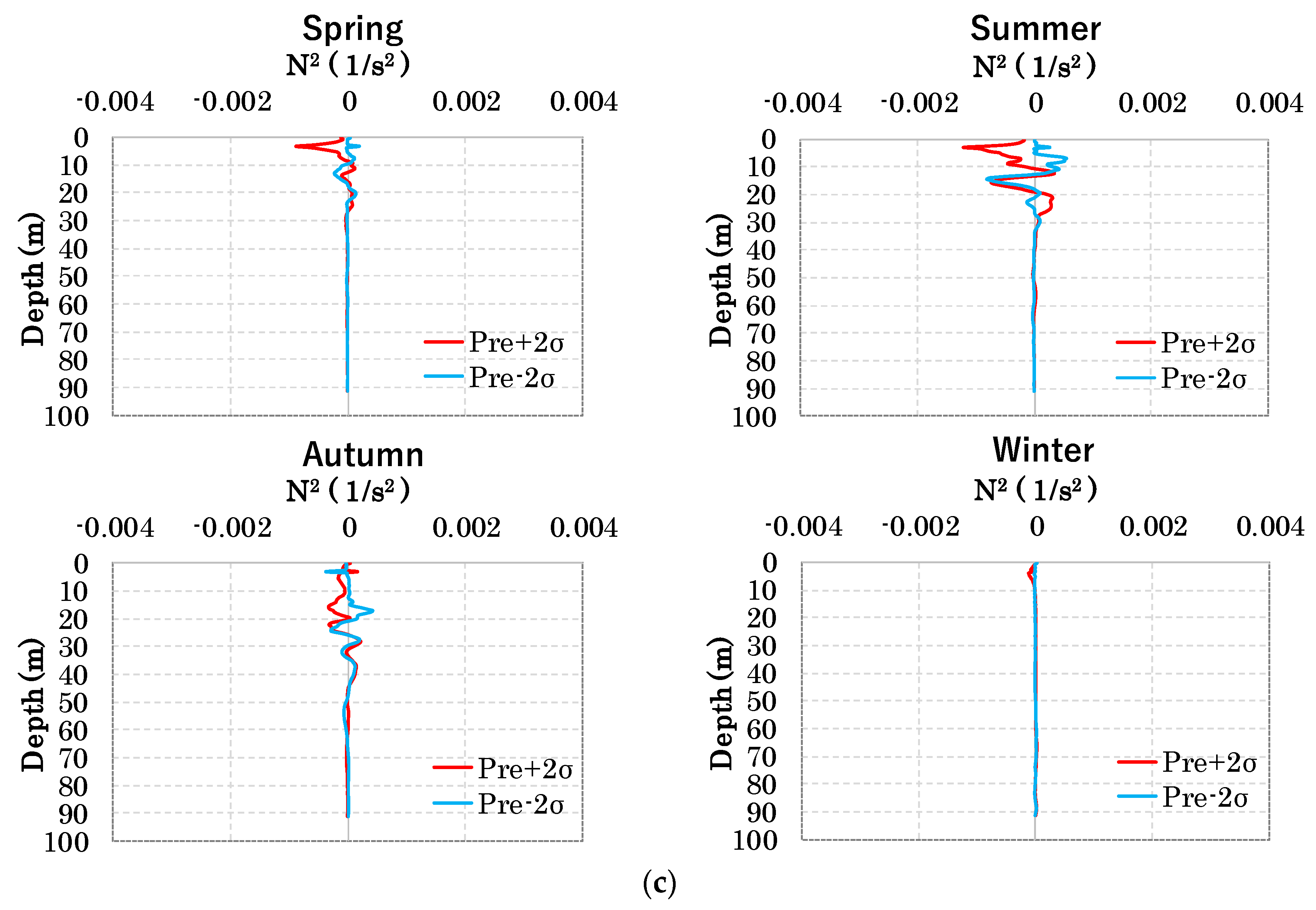Evaluation of the Impact of Meteorological Factors on the Stratification of Structure in Lake Biwa, Japan
Abstract
1. Introduction
2. Three-Dimensional Hydrodynamic Model of Lake Biwa
2.1. Calculation Area
2.2. The Governing Equation
2.3. Initial Conditions
2.4. Boundary Conditions
2.5. Computer Simulation Exemplifications
2.5.1. Baseline Simulation
2.5.2. Cases of the Variation of Air Temperature, Wind Speed, and Precipitation
2.6. Sensitivity Analysis on Air Temperature, Wind Speed, and Precipitation
3. Results and Discussion
4. Conclusions
Funding
Institutional Review Board Statement
Informed Consent Statement
Data Availability Statement
Conflicts of Interest
References
- Smith, V.H.; Schindler, D.W. Eutrophication science: Where do we go from here? Trends Ecol. Evol. 2009, 24, 201–207. [Google Scholar] [CrossRef] [PubMed]
- Chislock, M.F.; Doster, E.; Zitomer, R.A.; Wilson, A.E. Eutrophication: Causes, Consequences, and Controls in Aquatic Eco-systems. Nat. Educ. Knowl. 2013, 4, 10. [Google Scholar]
- Winder, M.; Schindler, D.E. Climatic effects on the phenology of lake processes. Global Change Biol. 2004, 10, 1844–1856. [Google Scholar] [CrossRef]
- Kumagai, M.; Ishikawa, K.; Jiao, C.; Aota, Y. Climate change and hypoxic phenomena in the norther part of Lake Biwa. Res. Rep. Lake Biwa Environ. Res. Inst. 2005, 22, 171–177. [Google Scholar]
- Kitazawa, D.; Ishikawa, T.; Kumagai, M. The analysis by the numerical simulation about the effects of the climate change for the past 50 years on an ecological system. Inst. Ind. Sci. 2010, 62, 45–49. [Google Scholar]
- Tsujimura, S.; Aoki, S.; Okumura, Y.; Yada, M.; Jiao, C.; Ishikawa, K.; Nakajima, T.; Ishikawa, T. Monitoring Analysis on Grasping the Actual State of Low Oxygenation in Lake Biwa and the Impact on the North Lake Ecosystem; Lake Biwa Environment Research Institute: Otsu, Japan, 2009; pp. 58–72. [Google Scholar]
- Livingstone, D.M. Impact of Secular Climate Change on the Thermal Structure of a Large Temperate Central Eu ropean Lake. Clim. Change 2003, 57, 205–225. [Google Scholar] [CrossRef]
- Arai, T. Climate change and variations in the water temperature and ice cover of inland waters. Jpn. J. Limnol. 2009, 70, 99–116. [Google Scholar] [CrossRef]
- Straile, D.; Jöhnk, K.; Henno, R. Complex effects of winter warming on the physicochemical characteristics of a deep lake. Limnol. Oceanogr. 2003, 48, 1432–1438. [Google Scholar] [CrossRef]
- Hayami, Y.; Fujiwara, T. Recent Warming of the Deep Water in Lake Biwa. Oceanogr. Jpn. 1999, 8, 197–202. [Google Scholar] [CrossRef][Green Version]
- Endoh, S.; Yamashita, S.; Kawakami, M.; Okumura, Y. Recent Warming of Lake Biwa Water. Jpn. J. Limnol. 1999, 60, 223–228. [Google Scholar] [CrossRef]
- Yoshimizu, C.; Yoshiyama, K.; Tayasu, I.; Koitabashi, T.; Nagata, T. Vulnerability of a large monomictic lake (Lake Biwa) to warm winter event. Limnology 2010, 11, 233–239. [Google Scholar] [CrossRef]
- Kanari, S. Internal Waves in Lake Biwa (I)—The Responses of the Thermocline to the Wind Action—Bulletin of the Disaster Prevention Research Institute. Ph.D. Thesis, Kyoto University, Kyoto, Japan, 1970; pp. 19–26. [Google Scholar]
- Saggio, A.; Imberger, J. Internal wave weather in a stratified lake. Limnol. Oceanogr. 1998, 43, 1780–1795. [Google Scholar] [CrossRef]
- Hayami, Y.; Fujiwara, T.; Kumagai, M. Internal Surge in Lake Biwa Induced by Strong Winds of a Typhoon. Jpn. J. Limnol. 1996, 57, 425–444. [Google Scholar] [CrossRef]
- Jiao, C.; Kumagai, M. Large Amplitude Nonlinear Internal Surge in Lake Biwa. Jpn. J. Limnol. 1995, 56, 279–289. [Google Scholar] [CrossRef]
- Fushimi, H. Influence of climatic warming on the amount of snow cover and water quality of Lake Biwa, Japan. Ann. Glaciol. 1993, 18, 257–260. [Google Scholar] [CrossRef][Green Version]
- Furukawa, H.; Kawamura, K.; Hara, T.; Kido, K.; Fukuju, S. Fundamental study on dissolved oxygen supply into deep layers in lake biwa. J. Jpn. Soc. Civ. Eng. 2007, 63, 144–153. [Google Scholar] [CrossRef][Green Version]
- Koue, J.; Shimadera, H.; Matsuo, T.; Kondo, A. Evaluation of Thermal Stratification and Flow Field Reproduced by a Three-Dimensional Hydrodynamic Model in Lake Biwa, Japan. Water 2018, 10, 47. [Google Scholar] [CrossRef]
- Sahoo, G.B.; Forrest, A.L.; Schladow, S.G.; Reuter, J.E.; Coats, R.; Dettinger, M. Climate change impacts on lake thermal dynamics and ecosystem vulnerabilities. Limnol. Oceanogr. 2016, 61, 496–507. [Google Scholar] [CrossRef]
- Anderson, E.J.; Stow, C.A.; Gronewold, A.D.; Mason, L.A.; McCormick, M.J.; Qian, S.S.; Ruberg, S.A.; Beadle, K.; Constant, S.A.; Hawley, N. Seasonal overturn and stratification changes drive deep-water warming in one of Earth’s largest lakes. Nat. Commun. 2021, 12, 1688. [Google Scholar] [CrossRef]
- Woolway, R.I.; Sharma, S.; Weyhenmeyer, G.A.; Debolskiy, A.; Golub, M.; Mercado-Bettín, D.; Perroud, M.; Stepanenko, V.; Tan, Z.; Grant, L.; et al. Phenological shifts in lake stratification under climate change. Nat. Commun. 2021, 12, 2318. [Google Scholar] [CrossRef]





| JFY | 2007 | 2008 | 2009 | 2010 | 2011 |
|---|---|---|---|---|---|
| AT (K) | 288.10 | 288.35 | 288.15 | 288.25 | 288.35 |
| WS (m/s) | 2.75 | 2.64 | 2.74 | 2.55 | 2.82 |
| Pre (mm/h) | 1560 | 1460 | 1450 | 1770 | 1900 |
| JFY | Spring | Summer | Autumn | Winter |
|---|---|---|---|---|
| AT (K) | 290.19 | 299.13 | 285.30 | 278.07 |
| WS (m/s) | 2.44 | 2.44 | 2.82 | 3.11 |
| Pre (mm/h) | 468.4 | 475.1 | 328.2 | 356.3 |
| Starting Date | Ending Date | Starting Date | Ending Date | Starting Date | Ending Date | Starting Date | Ending Date | Starting Date | Ending Date | |
|---|---|---|---|---|---|---|---|---|---|---|
| JFY | 2007 | 2008 | 2009 | 2010 | 2011 | |||||
| BASE | 4/8 | 12/15 | 4/12 | 12/10 | 4/7 | 12/5 | 4/19 | 12/6 | 4/6 | 12/17 |
| Period of thermocline (days) | 251 | 242 | 242 | 231 | 255 | |||||
| 244.2 (5-year average value) | ||||||||||
| AT + 2σ | 4/7 | 12/22 | 4/12 | 12/10 | 4/7 | 12/4 | 4/19 | 12/8 | 4/6 | 12/18 |
| Difference from BASE (days) | +8 | 0 | −1 | +2 | +1 | |||||
| +2 (5-year average value) | ||||||||||
| AT − 2σ | 4/10 | 12/11 | 4/14 | 12/10 | 4/7 | 12/4 | 4/19 | 12/9 | 4/6 | 12/16 |
| Difference from BASE (days) | −6 | −2 | −1 | +3 | −1 | |||||
| −1.4 (5-year average value) | ||||||||||
| WS + 2σ | 4/9 | 12/12 | 4/15 | 12/4 | 4/7 | 12/4 | 4/19 | 12/8 | 4/6 | 12/18 |
| Difference from BASE (days) | −6 | −11 | −13 | −5 | −9 | |||||
| −8.8 (5-year average value) | ||||||||||
| WS − 2σ | 4/7 | 12/20 | 4/6 | 12/23 | 4/6 | 12/12 | 4/18 | 12/14 | 4/5 | 12/24 |
| Difference from BASE (days) | +6 | +19 | +8 | +9 | +8 | |||||
| +10 (5-year average value) | ||||||||||
| Pre + 2σ | 4/8 | 12/15 | 4/12 | 12/12 | 4/7 | 12/4 | 4/19 | 12/8 | 4/6 | 12/18 |
| Difference from BASE (days) | 0 | +2 | −1 | +2 | +1 | |||||
| +0.8 (5-year average value) | ||||||||||
| Pre − 2σ | 4/8 | 12/15 | 4/13 | 12/10 | 4/7 | 12/4 | 4/19 | 12/8 | 4/6 | 12/19 |
| Difference from BASE (days) | 0 | −1 | −1 | +2 | +2 | |||||
| +0.4 (5-year average value) | ||||||||||
Publisher’s Note: MDPI stays neutral with regard to jurisdictional claims in published maps and institutional affiliations. |
© 2022 by the author. Licensee MDPI, Basel, Switzerland. This article is an open access article distributed under the terms and conditions of the Creative Commons Attribution (CC BY) license (https://creativecommons.org/licenses/by/4.0/).
Share and Cite
Koue, J. Evaluation of the Impact of Meteorological Factors on the Stratification of Structure in Lake Biwa, Japan. Hydrology 2022, 9, 16. https://doi.org/10.3390/hydrology9010016
Koue J. Evaluation of the Impact of Meteorological Factors on the Stratification of Structure in Lake Biwa, Japan. Hydrology. 2022; 9(1):16. https://doi.org/10.3390/hydrology9010016
Chicago/Turabian StyleKoue, Jinichi. 2022. "Evaluation of the Impact of Meteorological Factors on the Stratification of Structure in Lake Biwa, Japan" Hydrology 9, no. 1: 16. https://doi.org/10.3390/hydrology9010016
APA StyleKoue, J. (2022). Evaluation of the Impact of Meteorological Factors on the Stratification of Structure in Lake Biwa, Japan. Hydrology, 9(1), 16. https://doi.org/10.3390/hydrology9010016






